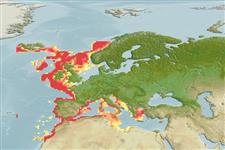Common names from other countries
Пластиножаберные (акулы и скаты) (sharks and rays) >
Rajiformes (Skates and rays) >
Rajidae (Skates)
Etymology: Leucoraja: Greek, leykos = white + Latin, raja = a fish, Raja sp. (Ref. 45335).
Environment: milieu / climate zone / depth range / distribution range
экология
морской демерсальный; пределы глубины 10 - 800 m (Ref. 106604). Temperate; 67°N - 27°N, 25°W - 37°E
Eastern Atlantic (Iceland, southern Norway, Skagerrak and Morocco) and the Mediterranean Sea.
Records as far south to Mauritania and Senegal could not be verified due to lacking descriptions and specimens; most are probably misidentifications of Leucoraja leucosticta.
Size / Вес / Возраст
Maturity: Lm ? range ? - ? cm
Max length : 120 cm TL самец/пол неопределен; (Ref. 4426); 117.0 cm TL (female); common length : 70.0 cm TL самец/пол неопределен; (Ref. 4426)
колючие лучи спинного плавника (общее число) : 0; колючие лучи анального плавника: 0. Snout short, its tip somewhat pronounced; upper surface entirely spinulose, about 8 thorns generally in a complete row around inner margin of eye and a triangle of thorns on nape or shoulder region; underside with prickles only on snout, between gill-slits, along abdomen, and at anterior margins of disc; tail only slightly longer than body; upper surface reddish-brown to dark brown with 4-6 creamy spots on each wing, underside white (Ref. 3167).
Found in offshore shelf waters and on upper slope, mainly around the 100 m line (Ref. 3167). Depth range from 70-275 m (Ref. 03167), and from 463-676 m in eastern Ionian Sea (Ref. 56504). Feed on all kinds of bottom animals (Ref. 3167). Oviparous. Distinct pairing with embrace. Young may tend to follow large objects, such as their mother (Ref. 205). Eggs are oblong capsules with stiff pointed horns at the corners deposited in sandy or muddy flats (Ref. 205). Egg capsules are 8.3-9.2 cm long and 4.6-5.3 cm wide (Ref. 41303, 41251, 41311). Maximum length for female is 117 cm (Ref. 41333).
Life cycle and mating behavior
Maturities | размножение | Spawnings | Egg(s) | Fecundities | личинки
Oviparous, paired eggs are laid. Embryos feed solely on yolk (Ref. 50449). With no definite egg laying period (Ref. 3167). Distinct pairing with embrace. Young may tend to follow large objects, such as their mother (Ref. 205).
McEachran, J.D. and K.A. Dunn, 1998. Phylogenetic analysis of skates, a morphologically conservative clade of elasmobranchs (Chondrichthyes: Rajidae). Copeia 1998(2):271-290. (Ref. 27314)
Статус Красного Списка МСОП (Ref. 130435)
CITES (Ref. 128078)
Not Evaluated
Угроза для людей
Harmless
Использование человеком
рыболовство: не имеет хозяйственного значения
дополнительная информация
инструменты
Специальные отчеты
Скачать в формате XML
ресурсы в Интернет
Estimates based on models
Preferred temperature (Ref.
115969): 7.5 - 14.2, mean 11.3 (based on 116 cells).
Phylogenetic diversity index (Ref.
82804): PD
50 = 0.5000 [Uniqueness, from 0.5 = low to 2.0 = high].
Bayesian length-weight: a=0.00269 (0.00165 - 0.00438), b=3.20 (3.06 - 3.34), in cm Total Length, based on LWR estimates for this species & Genus-body shape (Ref.
93245).
Trophic level (Ref.
69278): 3.5 ±0.37 se; based on food items.
устойчивость к внешним воздействиям (Ref.
120179): низкий, минимальное время удвоения популяции 4.5-14 лет (Fec assumed to be <100).
Fishing Vulnerability (Ref.
59153): High to very high vulnerability (72 of 100).
Climate Vulnerability (Ref.
125649): Moderate to high vulnerability (48 of 100).
